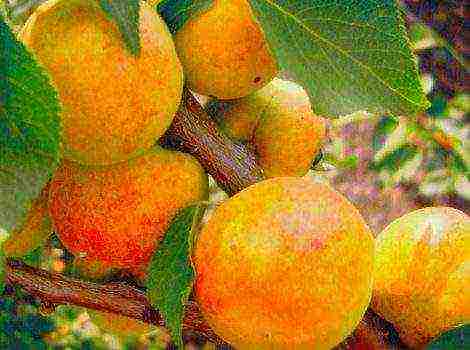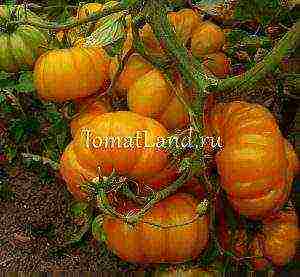Content [show]

Onion varieties for storage: description, reviews, photos
Onion Stuttgarter rizen, description - a variety of German selection, which has become by right the most popular in the world among varieties of onions. Early maturing: from sowing to ripening 120 days when grown from seeds and 60-70 days from seedlings. The bulb is flat-rounded, large, weighs 120-150 grams. The taste is spicy. It is appreciated for its yield (5 kg / m2 with minimal maintenance). Perfect evenness of the bulbs, excellent keeping quality. Resistant to downy mildew (downy mildew). Unpretentious and very flexible variety.
Bow Sturon and Centurion
New selection of the Stuttgarter rizen variety. Centurion is a heterotic hybrid (F1). Both of these varieties produce the highest quality, well-stored bulbs. The shape of the Sturon bulbs is perfectly round; the Centurion forms a somewhat elongated bulb. Round and elongated onions are very convenient for cutting, and the housewives have already appreciated this. These varieties have a smaller bottom and a narrower neck than Stuttgarter rizen. The small bottom reduces waste when cutting the onions. A narrower neck dries out faster, which means that the likelihood of pathogens getting to the bulb decreases. A higher yield of these onions was noted in comparison with the well-known Stuttgarter rizen variety.
Onion Orion, variety description
Exclusive grade of the English firm "Johnson". Orion is the result of many years of work to improve other breeding types. The cultivar gives leveled production of perfectly rounded, large (up to 150-200 grams) bulbs. Early ripening periods allow this onion to fully ripen even in Siberian conditions, which creates good preconditions for long-term storage. Many gardeners prefer this variety to everyone else.
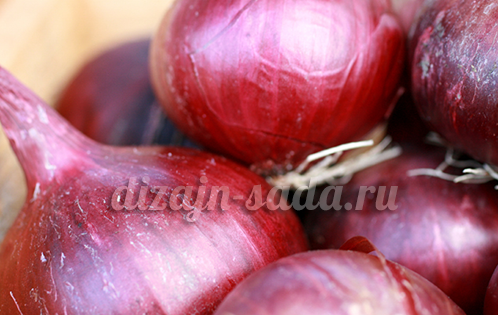
Popular varieties of red onions: a description of Bombay and Brunswick onions
Dutch varieties of red salad onions, used fresh in salads, preparations, for making marinades. The feathers and bulbs of these varieties are very juicy and tasty, mild, rich in vitamins and phytoncides. Large farms grow these onions for greens, which are in greater demand than yellow onions.
Bombay - mid-season variety of onions. The bulbs are flat, dense, large. The color of dry scales is dark red, juicy - light lilac. The taste is semi-sharp, the keeping quality of the variety is good.
The onion variety has long been loved and popular. Brunswick... This is an early maturing variety that does well in annual crops. Growing it through seedlings, in one summer you can get decent bulbs, up to 6 cm in diameter. They are flat-round, multi-nested in shape, the color of dry scales is bright purple, juicy - pink. Keeps well too.
Bow Carmen
Mid-season variety of onions. From germination to harvesting 120-130 days. The bulbs are beautiful, dark red with a purple tint, weighing 50-70 grams. The taste is semi-sharp. Differs in 100% ripening and good keeping quality. It is grown from both seedlings and seeds.
Red Baron onion
An early onion variety, the period from seed germination to technical maturity is 92-95 days. The bulbs are flat-rounded, weighing 18-24 grams. The taste is semi-sharp. Differs in a high content of ascorbic acid.
Advantages of the variety: stable yield, excellent ripening after ripening. To obtain larger bulbs, this variety is grown through seedlings.
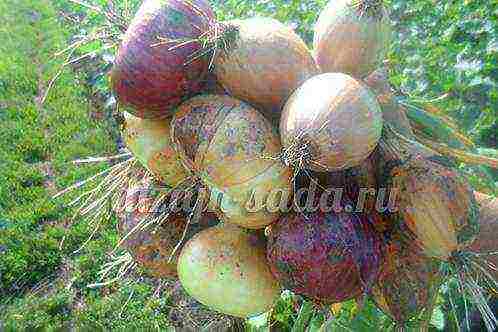
Onions of the Stuttgarten variety Riesen, Red Baron, Lyubchik, Victoria.
Varieties of large onions: description, photos, reviews Onion Globo
Mid-season variety, one of the largest among salad varieties. The bulb is round, light yellow, weighing up to 1 kg, very juicy, sweet taste. From seed to turnip, it is grown in 1 season only through seedlings.
Planting pattern for seeding: 7 x 35 cm.To obtain seeding from nigella, the seeding pattern is continuous: 1.5 x 1.5 cm.
Bow Exhibition
Medium late variety, forms a huge onion weighing 500-800 grams, sweet taste without bitterness. The shelf life of the crop is short, only 3-4 months. Grown only through seedlings.
Texas yellow onion
Popular Dutch variety. All Siberian gardeners are delighted with this onion. It grows easily and quickly, forms a good head in one season. Quite large bulbs have a straw-yellow color, dense and mild flesh. The variety is resistant to pink root rot.

Growing onions from seeds
Before sowing, onion seeds are soaked for 2-3 hours in water. Then they are kept for 3-4 days in a damp cloth. Be sure to disinfect the seeds in a dark solution of potassium permanganate (1 g per 1 liter of water) for 8 hours at a temperature of 40 ° C.
To get giant bulbs, seedlings are grown. To do this, in mid-March, seeds are sown in boxes filled with a soil mixture of humus, turf and mullein (9: 10: 1) with a neutral reaction. Sowing is sprinkled with a loose soil mixture through a sieve, then rolled. Onion shoots appear 7-12 days after sowing.
Maintain the temperature when growing seedlings: 20-22 ° C until germination, then 17-20 ° C during the day, 10-14 ° C at night. Drizzle with warm water.
Frequent airing does not allow the seedlings to stretch out unnecessarily.
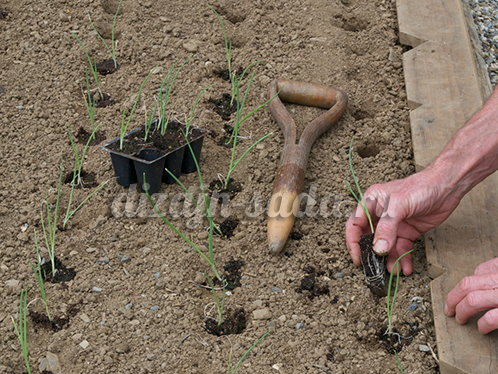
They are planted in a permanent place after two months, usually in mid-May. Immediately before planting, the seedlings are hardened for 2 days. Landings are placed in an open, unshaded place. The scheme for planting seedlings in open ground 20 x 30 cm.
Fresh manure is harmful. Planting is placed in the place where manure was introduced 2-3 years ago, since the plant forms a large leaf mass and loose bulbs unsuitable for storage using fresh manure. A month after planting the seedlings, and then, if necessary, the site is loosened and weeded. After the formation of the bulbs, the soil is raked away so that only the bottom is in the soil. In this case, the bulbs ripen faster and are better stored in the future.
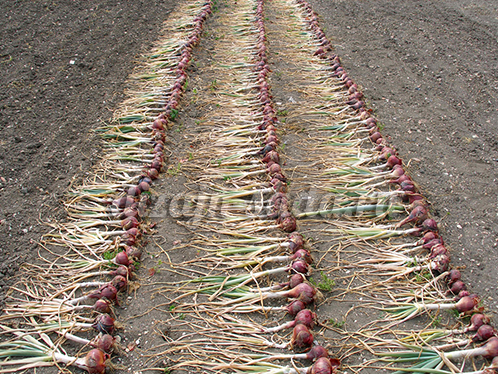
Harvesting turnip onions
In August, as soon as the feather begins to lay down, to accelerate the ripening of the bulbs, it is rolled. Lodging of leaves is the first sign of ripening. Simultaneously with the lodging and yellowing of the leaves, the roots die off at the bottom. Thus, the bow shows us that it has stopped growing. Onions are harvested closer to mid-August. The most important thing is not to be late in harvesting large and lying bulbs, since after the leaves have completely dried out, if the soil is wet, their roots begin to grow again, which reduces their keeping quality. Onions are harvested only in dry weather, it is good if there is a breeze that dries it outdoors. Drying the onions in the sun helps to decontaminate the bulbs and store them better. Then the onions are dried in the attic or in the shed for a month. During this time, the neck becomes thin and dry. Dried onions are peeled from dry scales and placed for long-term storage.
Growing onions through seedlings
Some people sow Dutch onion seeds in the early spring directly in the open field and get good results. But if you want to get the maximum yield in a small area, and such that it is worthy of its name Exhibition, you cannot do without seedlings. Many, after reading these lines, will immediately remember with sadness their windowsills, lined with seedlings of tomatoes and peppers. And then there's the bow! But let us reassure you in advance: from 0.4 g, or 100 seeds, more than 11 kg of onions will grow. Use 1 liter juice boxes to plant them on seedlings.They take up little space, are compactly placed on the windowsill, and the seedlings can be easily removed from them without injuring the roots.
Sowing is best in mid-March. Some vegetable growers recommend doing this in February, of course, if it is possible to regulate the temperature and light conditions (cool at night, illuminate in the morning and evening). Such terms are justified, as they will provide the output of better quality seedlings. But in an ordinary apartment with an early planting, the seedlings will stretch out and grow heavily.
Sowing Dutch onion seeds is a pleasure, as they are treated with fungicides and painted in bright colors, which allows you to control the planting density. It is enough to pour the seeds from the bag onto the prepared moistened soil and use a match to distribute them evenly over the entire area at a distance of about 0.5 cm. However, the seeds of the Globo variety are not treated with anything. In order not to thicken their planting, a layer of snow is placed on the soil. On a white background, the nigella is clearly visible. By the way, this method is very convenient for sowing very small dark seeds, for example, petunias, snapdragons, celery and other crops. When the snow melts, the seeds are pressed into the soil gradually and evenly provided with moisture, which contributes to their more friendly germination. Cover the onion seeds with a layer of soil no more than 1 cm, place the box in a plastic bag and place it under the battery. After a few days, the first green "loops" appear. This is a signal that it is time to expose the container to the light.
Top dressing onions
Water the seedlings sparingly, as the soil dries up. The need for feeding is determined based on the quality of the substrate. Use well-rotted manure or compost sifted through a metal mesh (0.5 cm mesh) or compost with the addition of ash and sand. A sufficient amount of nitrogen, potassium and trace elements in its basis makes it possible to do practically without additional feeding. Some phosphorus deficiency is compensated for by one-time watering with ammophos solution.
To prevent the seedlings from pulling out, if possible, spray it with an epin solution (this applies more to tomatoes). Many summer residents, when planting seedlings, make a gross mistake, strongly compressing the ground around the planted plants. In this case, pampered stems and fragile roots are often injured, and the access of oxygen to them is also blocked. It is better to make a depression with a small hoe, put the seedlings there, gently scoop up the soil to the roots and water. In this case, the soil itself is evenly compacted around the seedlings.
Despite the fact that the feather of the onion grows powerful and thick, it is often not worth cutting it off for consumption. After all, it is due to it that the onion grows, and the starting conditions for nigella and sevka are incommensurable. And in the shortest time it is necessary to achieve maximum results. The perennial leek and the annual Parade onion are grown on the green feather, which gives leaves until late autumn. Onions from seeds are "pinched" only occasionally, its greens are juicy, sweetish.
During the growing season, it is useful to sprinkle all onion plants with ashes a couple of times. In addition to potassium nutrition and a full range of trace elements, this will to some extent save plantings from fungal diseases. The rest of the dressing is carried out according to the usual scheme, familiar to every gardener. The main thing is to maintain the optimal distance between plants (5-6 cm) in a row when planting seedlings, although, looking at the thin borings, you just want to plant thicker. But this is not necessary, because a rapidly growing bulb needs a large area of nutrition.
Grow annuals only through seedlings. Moreover, it is recommended to do thickened crops, so that the bylochki support each other and do not fall, and when they are 10-15 cm, then cut them in half so that they go not upward, but in breadth. When planting, once again cut the greens by 1/3 and the roots by 1/3. That's the whole trick.
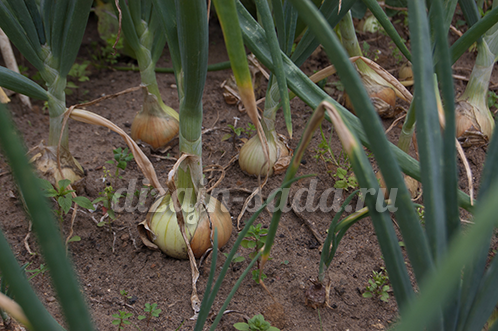
With any method of growing onions during the ripening period, when the feather is still green, it is necessary to create conditions so that as much nutrients as possible pass into the bulb, and at the same time to prevent the formation of new roots and regrowth, which will further negatively affect preservation. To prevent this from happening, in rainy weather, you should cover the plantings with pieces of old film, and then you do not need to cut the roots or "trample" the feather, as amateur vegetable growers advise. After harvesting, marketable onions are placed in plywood fruit crates, which ensure good air exchange.
You will have enough of your onions almost until the next harvest. The advantage of this method is obvious - the cost of packing even the most expensive seeds is incomparable with the price of a kilogram of seed. Under no circumstances will your onion “go to the arrow”, and you will get the opportunity to grow exactly the variety that you like best. After all, the assortment of nigella is much wider than the set.
source
Onions are used for cooking many dishes, so any housewife, when choosing crops for growing on her site, prefers several varieties at once. Variety in the beds allows you to create new masterpieces in the kitchen, and at the same time improve your gardening. In this article, we will find out what types of onions are, home and wild, talk about their description and find out the main characteristics.
Varietal variety of onions: what types are there?
Adopting the experience of their ancestors, preference is often given to the same varieties of onions when planting a vegetable garden. It's time to change stereotypes, improve and achieve new results, because the dish can sparkle with new flavor notes if you use Setton or Leek instead of the usual onion. Moreover, in central Russia, you can plant a large number of varieties, as practice has shown. At least lettuce, even green. And then we will find out where which species can grow.
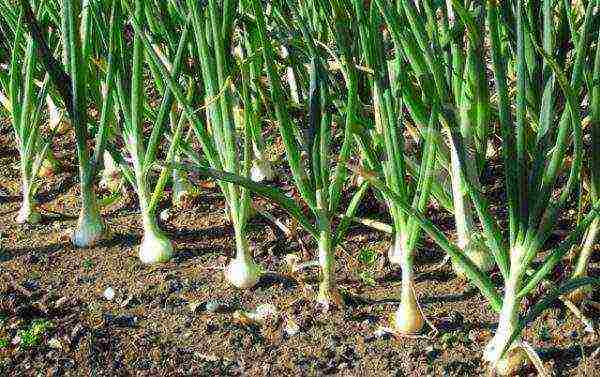 Onions in the garden
Onions in the garden
To determine the choice of seeds for bulbous plants, you need to familiarize yourself with the features of different species, their preferences and planting nuances. It is also worth paying attention to the correspondence of the growing conditions of the culture and the climate of the region. This is what will be discussed in this article.
The most popular onion varieties
All varieties of culture differ not only in taste, but also in planting rules, ripening period, and yield.
Onion sets
- Chalcedony grows outdoors, is very popular among gardeners in the southern regions of Russia. Suitable for growing feathers and root crops. The ripening period (from planting to harvesting) is 95-110 days. An average of 4 kg is removed from a square meter with a marketable weight of one small specimen of 85-100 grams. Sometimes there are onions weighing up to 400 grams. There is a good immunity to peronosporosis, vulnerability to cervical rot. Taste: pleasant with a slight spice.
- Stuttgarter Riesen early ripening, from sowing to harvesting takes about 3 months. Rounded-flat onions weigh 150-250 grams on average, but there are also giants up to 350 grams. The plant rarely shoots arrows, does not become covered with spots typical of downy mildew. Taste: spicy with a pungent aroma.
- Sowball is characterized by large, rounded bulbs with an average weight of up to 200 grams. The root crop ripens for about 100-110 days, gives a good harvest. Taste: delicate with a slight hint of pungency, used mainly for making salads.
Onions (turnip)
- Goldfish represents a mid-season species, differs in round, medium-sized onions weighing about 60-70 grams. Used for greenery and growing turnip for planting next season. The middle is white and juicy with a slight edge.
- The shaman belongs to the early ripening varieties, ripens in 86-95 days. The root crop has an elongated shape, a pink-red rather juicy middle. The average weight of a turnip is 55-65 gr.Advantages: stable high yield, high taste. Stored for a short time.
- Oporto ripens in 98-107 days, belongs to the mid-season species. The weight of the turnip reaches 270-300 gr., The shape is correct round. Advantages: high yield when using seedlings, immunity to diseases and pests, retains its presentation for a long time. The palatability allows the use of porto for all types of processing.
Varieties of salad onions
- Exibishen ripens for about 130 days and tastes very sweet with abundant juice. The turnips are round and very large, reaching 550 gr., But there are also specimens of 700-800 gr. The only drawback of the culture is considered a small storage period (no more than 3 months).
- Yalta is incredibly popular due to its excellent taste. The plant ripens in 138-150 days, turnips are large flattened purple tones, reaching an average of 200 grams. In the middle lane, the variety can be grown using seedlings. Onions are stored for up to 4 months.
- Ermak is the ripening record holder, the crop is removed 75-95 days after sowing. Differs in good immunity, long shelf life (up to the next season). The gastronomic feature is a soft juicy texture with a slight pungency.
Red onion
- The crimson ball ripens in 85-95 days, yields a stable harvest every year. Dark purple rounded turnips live up to the name. The middle is juicy with a pleasant taste, set off by a light speck. The drawback is the short shelf life (up to 4 months).
- Campillo F1 Introduces Red Onion Hybrid, which has a rounded shape with a dense center and a pleasant purple tint. Advantage - pigment does not transfer to kitchen utensils and fabrics. Taste qualities: delicate structure with abundant juice production, well-perceptible sweetness. It can be stored for a long time without losing its properties.
- Retro is famous for its high yield and fast ripening (up to 90 days). The middle is tender, dark red with white stripes. Onions are very sweet without pungency, so they are even added to children's salads.
White onion
- Albenka is fast ripening (up to 95 days) and interesting taste qualities that combine light pungency and sweetness. Grown for herbs and onion sets. Not suitable for long-term storage.
- The white globe has good seed germination and quick ripening. You can harvest the crop in 95-105 days after planting. A rounded, slightly elongated turnip weighs an average of 160 grams. The variety has a high stable yield, immunity to fusarium.
- Sterling is a group of white onion hybrids with a ripening period of 110-120 days. The mass of an average turnip is 120-200 gr. Rounded shape with white husk. The middle is soft and juicy with an unusual taste that is not similar to other species. The storage of the root crop is short (3-5 months), but when grown, immunity to many diseases and pests is noted.
Sweet onion
- Kaba ripens in 145-155 days, has immunity to disease. Productivity is stable, stored for up to 4-5 months. The weight of a round turnip with a slight pressure is 80-125 grams. The middle is dense, but sweet and juicy.
- Globo ripens 110-125 days, the size of the root crop is a real giant. The weight of one onion reaches 600-900 grams. The taste is delicate, sweetish, ideal for salads and various other dishes. Growing a crop from seedlings, you can get a crop from 1 m2 to 12 kg.
- Spanish 313 is distinguished by its yield, immunity to diseases and pests, suitable for fresh and processed consumption. The weight of an average turnip is 120-150 grams, the shape is round and large. Onions have long been recognized by domestic gardeners and are popular due to their unpretentious care and sweet taste. Productivity from 1m2 - 4-5 kg.
Names of varieties of onions for storage
- Red Baron has a dark red color, the onion is rounded, slightly flattened. The plant ripens in just 90-95 days, the weight of the turnip is 95-110 grams. Advantages: stable, high yield, light taste with a slight spice.
- Volsky bow prefers nutritious light soils. The root crop ripens in 120-140 days with an average weight of 90-140 grams. The turnip grows in such a way that the top is on top of the soil, which simplifies collection. Taste features: spiciness is well felt.
- Orion represents an exclusive hybrid, which English breeders have been working on for a long time. The variety ripens quickly, which makes it possible to grow a crop even in the northern regions. The turnip has a regular rounded shape of a beautiful purple color, weighing an average of 150-200 grams. Orion is very popular among gardeners, but most likely it will not grow either in the suburbs or in the Urals.
The best bulbs for the Moscow region
- Centurion has gained popularity all over the world due to its high taste. The rounded-elongated turnip reaches a weight of up to 110 g... The yield is average, but stable (up to 3-4 kg per 1 m2). Advantages of the variety: not susceptible to the release of arrows, long shelf life (up to 8-9 months), resistance to decay. The root vegetable has a pungent taste.
- Hercules is considered a prolific crop, yielding from one square meter to 8-9 kg of root crops. Breeders, working on a hybrid, initially set the task of obtaining a long-lasting onion. The result exceeded expectations - good resistance to diseases, long-term storage without loss of useful properties, resistance to the whims of nature. The weight of the turnip is up to 120 gr., The taste is at a height (light pungency, juiciness, moderately sweet).
- Sturon represents a hybrid grown by Dutch breeders. As a result of painstaking work, a variety was obtained that is resistant to diseases and pests, which retains its presentation well for 9-10 months. The plant ripens in 100-115 days, the weight of an average turnip is 120-150 grams. Gastronomic feature: suitable for all types of processing, neutral flavor notes with a slight spice.
Observing all the recommendations for soil preparation, planting and care, you can remove a completely bountiful harvest of onions from the beds. And even celebrate a giant root crop every year, winning their own records.
Do you want to grow onions but don't know which variety to choose? Then be sure to read our article.
We will introduce you to the best varieties of onions that you can grow on your site without any problems.
When choosing a variety of onions for a summer residence, pay attention to its regionality. Depending on the area of growth, onion varieties can be divided into 2 types:
- southern;
- northern.
Southern varieties of onions do not last very long, but they are not very spicy in taste. Some of them are called sweet at all and are referred to as salad types of onions. If you want to get southern varieties of onions in the northern regions or in the middle lane, it is worth growing them through seedlings.
Northern varieties of onions are pungent in taste, but have excellent keeping quality.
White onions are also distinguished. It has a softer and sweeter taste. White onions are among the salad varieties. However, such bulbs are poorly stored, quickly damaged by pests, soften and rot.
In France, it is from white onions that the famous onion soup is prepared.
Onion varieties are also distinguished according to the growing season: in the early varieties this period is 90-100 days, in the middle ones - 100-120 days, and in the later ones - more than 120 days.
Depending on the size of the bulb, there are 3 types:
- small - less than 50 g;
- medium - 50-100 g;
- large - more than 100 g.
Depending on how many bulbs can form in the nest, varieties are distinguished:
- small-sized (1-2 bulbs);
- medium-sized (3-4 bulbs);
- multi-nested (5 or more bulbs).
Nesting largely depends on the size of the seedlings, as well as on the growing conditions of the crop. If the seed is larger, and the soil fertility and moisture is higher, then the number of bulbs in the nest will be greater.
Spicy, semi-sharp, sweet onions - looking for differences
All spicy varieties of onions are early ripening. They are distinguished by good keeping quality, high content of essential oils and sugars, but at the same time they are less productive. Such varieties, as a rule, are covered with several layers of outer scales, and therefore they can be removed not only manually, but also using specialized equipment.
Peninsular onion varieties have few outer scales, and the flesh is not as dense and sharp. Such a bow, when harvesting with special equipment, is often injured and quickly deteriorates. Semi-sharp varieties are considered to be medium-hard and take longer to ripen. However, they give a higher yield than sharp varieties.
Sweet onions taste great and are often used fresh. They give a high yield, but it is stored for a short time. Sharp and semi-sharp onions can be grown in any region. In the southern regions, during the growing season, crops can be obtained even from seeds. And in the middle lane and northern zones - only through seedlings or by planting seedlings. Sweet varieties are grown mostly in hot southern regions from seeds.
Popular varieties of red, yellow and white onions
We bring to your attention well-proven varieties of onions, which are preferred by the absolute majority of gardeners.
Kaba
Late-ripening variety with dense round-flat and rounded bulbs running downwards. The pulp is white, sometimes with a greenish tinge. The outer scales are yellow or light brown. The variety is not resistant to downy mildew (downy mildew), it is also damaged by onion fly.
| Use | Taste | Growing method | Bulb weight (g) | Keeping quality | |
| peninsular |
70-145 |
unsatisfactory | |||
Red baron
Early ripe variety. The bulbs are round, flattened at the top and bottom, red or dark purple on the outside and inside. For larger bulbs, it is recommended to grow this variety through seedlings.
| Use | Taste | Growing method | Bulb weight (g) | Keeping quality | |
| peninsular |
130-150 |
excellent | |||
Snowball
A medium early variety of white onions. It has almost round and white (both outside and inside) bulbs. Quite resistant to shooting, but moderately susceptible to downy mildew and neck rot.
| Use | Taste | Growing method | Bulb weight (g) | Keeping quality | |
| peninsular |
120-200 |
average | |||
Strigunovsky local
An early early ripening variety. It has round, dense bulbs with light pulp and pink or brown outer scales. It can grow in both hot and cool climates without problems.
| Use | Taste | Growing method | Bulb weight (g) | Keeping quality | |
| very spicy |
45-80 |
excellent | |||
Sturon
Mid-season variety. The bulbs are round, white in color, densely covered with a yellow-brown skin. Resistant to diseases and shooting.
| Use | Taste | Growing method | Bulb weight (g) | Keeping quality | |
|
|
spicy |
70-180 |
excellent | ||
Texas yellow
Early ripe variety. The bulbs are round, rather large, straw-yellow in color with dense white flesh. Resistant to pink root rot.
| Use | Taste | Growing method | Bulb weight (g) | Keeping quality | |
| peninsular |
|
80-150 |
average | ||
Centurion F1
Medium early hybrid with medium-sized, round-elongated bulbs. The pulp is juicy, white, the outer scales are golden brown. The hybrid is resistant to shooting and major onion diseases.
| Use | Taste | Growing method | Bulb weight (g) | Keeping quality | |
| spicy |
65-150 |
excellent | |||
Each of these varieties has stood the test of time and is popular with gardeners. Pay attention to them when you go to the store for sets or onion seeds.
.
Many summer residents and consumers simply trust red onions. This variety has become widespread due to its qualities.
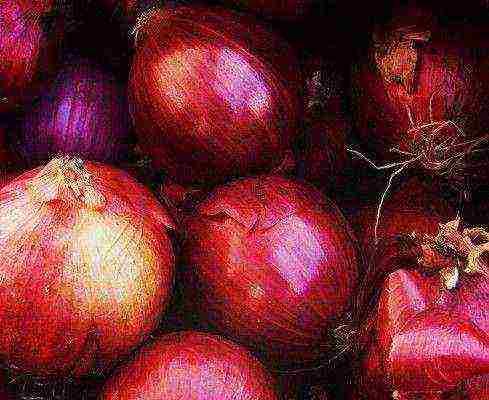
Red onions are in high demand among consumers.
Red onion varieties
Positive qualities of red onion varieties:
- beautiful appearance;
- excellent taste.
The taste of red onion varieties is sweet and juicy. Pointed varieties among the red bulbs are also endowed with a red flavor. There are many different varieties of red onions:
- Crimson ball.
- Greatfull.
- Campillo.
- Red Braunschweig.
- Retro.
- Black Prince.
- Yukont.
The crimson ball variety of red onions is an early ripening onion variety. It is ready to eat in three or four months. The bulbs are round and have a purple hue on the outer and inner layers.

Crimson ball - early ripening variety
The variety of this type gives a plentiful yield, and it is recommended for use in an unprocessed form. Growing the variety is preferable in the form of seedlings, since planting bulbs with seeds is a longer and more complicated process.
The greatful variety is a hybrid, it belongs to the varieties of medium ripening terms. Ripening is carried out on the one hundred and twentieth day from the moment of planting. The bulbs are the same size. this type of product is stored for a long time. This is the main advantage of this variety.
Campillo onions are resistant to disease and cold climates. The taste of the variety is soft and suitable for fresh consumption.
Braunschweig red onion yields a harvest in the first year of planting, the ripening rate is average, the taste is excellent.
Retro red onion belongs to the early ripening onion varieties. Three months after planting the material, large bulbs are formed. The outer parts of the bulb have a red tint, while those. who eat white. It is consumed mainly fresh, like all varieties of red onions.
Black Prince is a red onion variety that has a sweet-pungent flavor. They are stored for a long time and are endowed with a complex of vitamins and minerals.
Yukont ripens quickly, gives abundant harvests and is stored for a long time. The taste of the variety is superior in its pungency.
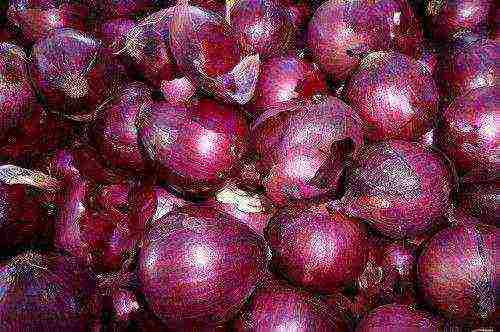
Black Prince is suitable for long-term storage
Caring for red onions
The red onion sevok does not differ from the rest of the onion varieties. Sweet products of onion sets are harvested in advance. The main requirements for choosing the final type of sweet onion are your climatic zone and soil condition.
The culture produces crops on fertile sandy loam soil. Before planting a culture, a land plot is prepared. First of all, you should allocate for planting sweet onions that land where potatoes, tomatoes or legumes previously grew. This limitation lies in the condition of the soil after the harvest of the predecessors. These are the good neighbors for the vegetable. After other crops, the expected onion crop may not appear. Or the product will be weak, unmarketable, and unsuitable for human consumption.
The most offensive thing is when your work goes down the drain, so you should carefully consider planting and the initial care of the crop. First, you need to dig up the land. Loosening the soil has a beneficial effect on the condition of the soil. Planting and preparation of onion sets is a lengthy process, and the very care of the site of onion sets is carried out quickly and without problems.
The selected seed planting material is soaked in a solution of vitriol or manganese. This is carried out in order to obtain a rich crop of onions and adapt the culture.
The harvest of seedlings will turn out to be good if the land has been well prepared.
First of all, carefully dig up the soil, then clear the land of weeds. When this stage of preparation is complete, treat the land from pests. Preparation of a land plot for planting sevka is carried out long before planting.
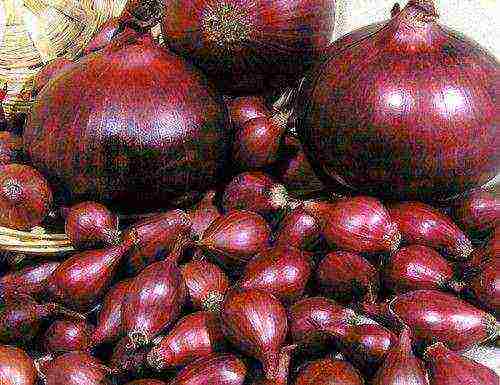
To prevent the sevok from being affected by the disease, it must be treated with potassium permanganate
The difference in the care of the site is at what time of the year the crop is planned to be planted. After the site has been processed and cleaned, fertilizers are laid. It is recommended to use a moderate amount of organic and mineral fertilizers.
Soaked seedlings or onion seeds are planted in a prepared plot of land, observing the distance between the beds and seedlings. When the first shoots appear, the rows should be thinned from weak and damaged shoots.
An additional condition when choosing a planting material is its appearance: identical, even bulbs without defects. When the seedlings germinate, the land is additionally plowed during watering. Use warm water in moderation. Excessive or excessive watering is negative.
The site where the landing is carried out must be located on a hill. Its place should be open for illumination and closed from through winds, but the onion does not like excessive heat.
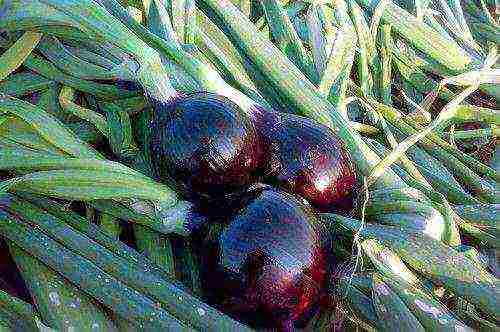
Red onions love bright places in the hills.
Beneficial features
Sweet red onions are packed with many vitamins and minerals:
- vitamins of groups A, B, C;
- phosphorus, magnesium, chromium, iron, sodium and sulfur.
This product is endowed with a complex of vitamins and minerals that contribute to the growth of immunity and the body's resistance to various diseases. The use of the product allows you to establish the work of the digestive organs and increases the metabolic rate.
If you have diabetes mellitus or you have high cholesterol levels, then eating the product fresh will allow you to cope with these ailments and restore a healthy state of the body. For the effect to arise from the use of onions, it is added to food three onions per week.
The top layer of the onion has the greatest amount of nutrients. Only red onion contains a substance that has a beneficial effect on the state of the entire body.
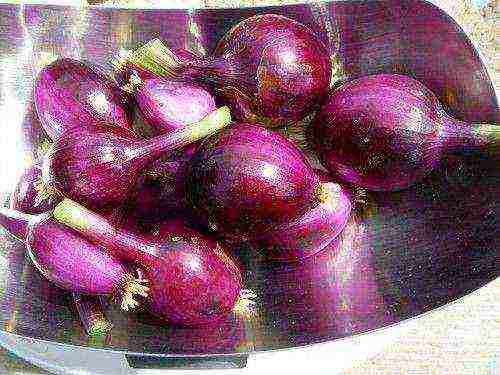
Red onions are good for diabetics
Apart from red onions, this substance is not found anywhere else, which explains the need to regularly eat red onions. Regular consumption of red onions allows you to get a large amount of vitamins and minerals without using pharmaceutical preparations.
Red onions are mostly consumed fresh. After undergoing heat treatment, the onion loses its useful properties. Therefore, you need to eat fresh onions regularly.
Onions with a golden crust are more popular in food. The product itself is added by us to all kinds of dishes, but the benefits of red onion should cause more popularity from this use. Moreover, the red onion does not have a sharp taste, it is sweet and juicy.
Recipes for making salads with red onions are common. you can come up with your own by adding your favorite ingredients to suit your taste. It is important to consume the product in winter and early spring, when the human immune system is weakened.
Subscribe Be aware of new products on our site

